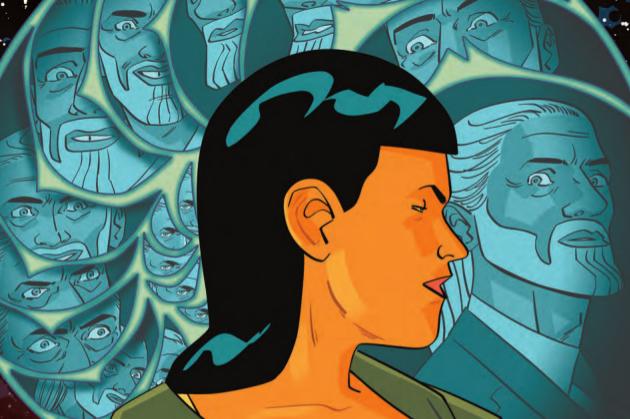2000AD, PROG 2106 REVIEW
Artists: Henry Flint; Colin MacNeil; INJ Culbard; Pye Parr; Richard Elson
Colourists: Chris Blythe; Dylan Teague; Abigail Bulmer
Letterers: Annie Parkhouse; Ellie De Ville; Simon Bowland; Pye Parr
Publisher: Rebellion
“When in doubt” wrote Raymond Chandler of storytelling, “have a man come through the door with a gun in his hand”.
In the shocking finale of last week’s Judge Dredd: The Small House, the complex conspiracy at the heart of the Dredd’s world was brought crashingly close by a man with a gun. Dirty Frank has always been a comedic figure, filled with loyalty and sadness. Just as his friends uncovered the reach of Smiley’s reign, Frank appeared to interrupt. What could have driven Frank to murder Judge Sam and betray his friends? In this Prog, we find out.
Between screaming in German and narrating his own adventures, Dirty Frank has always had his small occasional moments of clarity. His terrible realisation of his part in Smiley’s plan is truly heartbreaking.
Frank’s betrayal shatters Dredd’s small group of confidants, and here they deal with the immediate aftermath. Dredd’s grim faced, silent response is more powerful that any angry outrage..and when his response finally does come, it transforms the order of things once again. Some fantastic art from Henry Flint leaves us with a pair of eyes staring from the page, full of anger, confusion, and fear. Dredd’s hunched figure is left looking small. The Small House continues to be the most powerful and far reaching Dredd tale in years.
If you’ve not been following Brink: High Society, this Prog sees cleaner Kurtis continue a conversations with her Human Resources manager.
If you have been following Brink, then “call me Joel”, the most inappropriate HR manager ever, interviews Kurtis, unaware she’s an undercover agent investigating strange occurrences, at the heart of which is the dark cult of which Joel is a member.
In Brink, what is suggested is more important that what is said. Joel’s behaviour demonstrates that his employer isn’t subject to the usual laws or standards. His assumption that Kurtis is uneducated lays bare the class system of this new world. His eagerness to turn the conversation to the subject of dreams, and how quickly he ends the conversation when he looses control of it, ably shows the power he is familiar with holding.
Art from INJ Culbard perfectly suits Brink. On the face of it, these panels are simplistic, but beneath the obvious is another layer. The lighting is strange and unnatural, characters are hemmed in by rigid panels – although watch what happens when Kurtis suggests she has hidden depths…
It’s the small things that make Brink. But beneath it all is the terror of an unknowable universe that threats to swallow us whole. Creators Dan Abnett and INJ Culbard understand that true Lovecraftian horror is found not in the supernatural but in the awful secrets that twist people, but can’t be directly confronted
Humans: greasy, sweaty things, tottering around on two legs like they own the place. Their moist innards always on the verge of spilling out, getting a sticky mess everywhere. Hairy, foul beasts, whose oily surface is the setting for Tharg’s 3rillers: Infestonauts Are Go!. Art by Pye Parr is busy and colourful, like a gleefully gross kid’s cartoon. It’s full of funny detail (“Dog dogs: Man’s best, fried!”) and entirely appropriate techno-babble. Infestonauts starts in a futuristic space port before zooming in on the hairsuite surface of Dave Dwayneski, where micro-robots fight an infection.
As a sequel to Intestonauts Are Go! from several years ago, this Tharg’s 3riller may escape the issues with the format. 3rillers ("threerillers"? ) often feel like Future Shocks given unnecessary detail, or longer stories shorn of plot and character. Infestonauts Are Go! is light, fun and exciting, with a really original set up.
In a series of explosions, Nolan tries to kind out more about the demon who was living inside his brother’s head in Skip Tracer: Legion. Where did Nolan get his seemingly unlimited powers, and why hasn’t he used these abilities before now? What do the consociation have to do with this? Is “consociation” even a word? What is a “Skip Tracer” anyway? Why would you stop a man from holding someone at gunpoint, just so you could hold the same person at gunpoint? Did things just get suddenly biblical?
Be quiet and eat your popcorn. Skip Tracer is silly, and doesn’t make a whole lot of sense. It relies far too heavily on it’s influences, and is mostly predictable. But it’s fun. Nonsense fun. Isn’t that why we’re here?
Kingdom: Alpha and Omega asks important questions like “what is self?” and “why am I here?”, whilst having its characters run around cutting the heads off giant insects.
Gene has been presented with a simple dilemma that we’ve all faced at some point in our lives: Either you battle the humans who created you and the giant bugs who conquered the Earth...or you learn to live in peace and harmony with a mind-controlling tick affixed to your body, regulating your every thought. That sounds nice. Gene, however, has never witnessed the trash-fire of Twitter and so continues to struggle with the choice.
Deadlines have been set, with the humans ready to nuke the entire gang if they don’t get what they want. Here, the immediate danger is dispensed with, an odd choice storytelling wise. But more drama is added as Gene reveals a secret, and the Riders decide to force the situation. Just as things were getting a little too philosophical, a dog soldier comes through the door with a metaphorical gun





